
Gagra is a town in Abkhazia/Georgia, sprawling for 5 km on the northeast coast of the Black Sea, at the foot of the Caucasus Mountains. Its subtropical climate made Gagra a popular health resort in Imperial Russian and Soviet times.
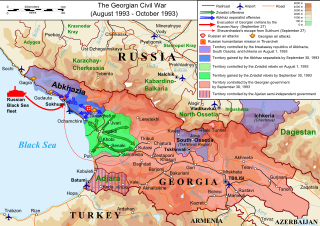
The Georgian Civil War lasted from 1991 to 1993 in the South Caucasian country of Georgia. It consisted of inter-ethnic and international conflicts in the regions of South Ossetia and Abkhazia, as well as the violent military coup d'état against the first democratically-elected President of Georgia, Zviad Gamsakhurdia, and his subsequent uprising in an attempt to regain power.

The Abkhazia conflict is a territorial dispute over Abkhazia, a region on the eastern coast of the Black Sea in the South Caucasus, at the intersection of Eastern Europe and Western Asia. The conflict involves Georgia, Russian Federation and Russian-backed self-proclaimed Republic of Abkhazia, internationally recognised only by Russia, Venezuela, Nicaragua, Nauru, and Syria; Georgia and all other United Nations members consider Abkhazia a sovereign territory of Georgia. However, as of 2023, Georgia lacks de facto control over the territory.
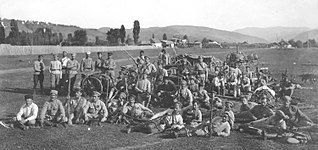
The Sochi conflict was a three-party border conflict which involved the counterrevolutionary White Russian forces, Bolshevik Red Army and the Democratic Republic of Georgia, each of which sought control over the strategic Black Sea town of Sochi. The conflict was fought as a part of the Russian Civil War and lasted with varying success from July 1918 to May 1919, and ended through British mediation.
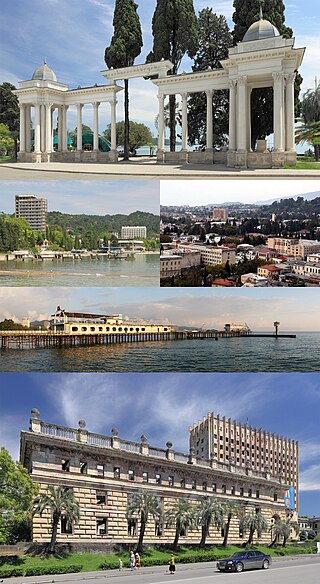
Sukhumi is a city in a wide bay on the Black Sea's eastern coast. It is both the capital and largest city of the Republic of Abkhazia, a partially recognised state that the international community considers a part of Georgia. The city has been controlled by Abkhazia since the Abkhazian war in 1992–93. The city, which has an airport, is a port, major rail junction and a holiday resort because of its beaches, sanatoriums, mineral-water spas and semitropical climate. It is also a member of the International Black Sea Club.

The ethnic cleansing of Georgians in Abkhazia, also known in Georgia as the genocide of Georgians in Abkhazia, refers to the ethnic cleansing, massacres, and forced mass expulsion of thousands of ethnic Georgians living in Abkhazia during the Georgian-Abkhaz conflict of 1992–1993 and 1998 at the hands of Abkhaz separatists and their allies. Armenians, Greeks, Russians, and opposing Abkhazians were also killed.

The history of Abkhazia, a region in the South Caucasus, spans more than 5,000 years from its settlement by the lower-paleolithic hunter-gatherers to its present status as a partially recognized state.

Nestor Apollonovich Lakoba was an Abkhaz communist leader. Lakoba helped establish Bolshevik power in Abkhazia in the aftermath of the Russian Revolution, and served as the head of Abkhazia after its conquest by the Bolshevik Red Army in 1921. While in power, Lakoba saw that Abkhazia was initially given autonomy within the USSR as the Socialist Soviet Republic of Abkhazia. Though nominally a part of the Georgian Soviet Socialist Republic with a special status of "union republic," the Abkhaz SSR was effectively a separate republic, made possible by Lakoba's close relationship with Joseph Stalin. Lakoba successfully opposed the extension of collectivization of Abkhazia, though in return Lakoba was forced to accept a downgrade of Abkhazia's status to that of an autonomous republic within the Georgian SSR.
The Georgian–Ossetian conflict of 1918–1920 were a series of uprisings, which took place in the Ossetian-inhabited areas of what is now South Ossetia, a breakaway republic in Georgia, against the Transcaucasian Democratic Federative Republic and then the Menshevik-dominated Democratic Republic of Georgia which claimed several thousand lives and left painful memories among the Georgian and Ossetian communities of the region.

The Socialist Soviet Republic of Abkhazia was a short-lived republic within the Caucasus region of the Soviet Union that covered the territory of Abkhazia, and existed from 31 March 1921 to 19 February 1931. Formed in the aftermath of the Red Army invasion of Georgia in 1921, it was independent until 16 December 1921 when it agreed to a treaty that united it with the Georgian Soviet Socialist Republic. The SSR Abkhazia was similar to an autonomous Soviet republic, though it retained nominal independence from Georgia and was given certain features only full union republics had, like its own military units. Through its status as a "treaty republic" with Georgia, Abkhazia joined the Transcaucasian Soviet Federative Socialist Republic, which united Armenian, Azerbaijani, and Georgian SSRs into one federal unit when the latter was formed in 1922. The SSR Abkhazia was abolished in 1931 and replaced with the Abkhaz Autonomous Soviet Socialist Republic within the Georgian SSR.
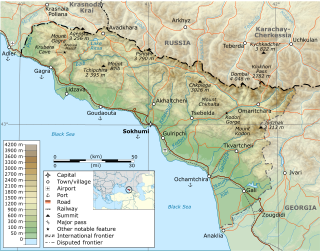
The War in Abkhazia was fought between Georgian government forces for the most part and Abkhaz separatist forces, Russian government armed forces and North Caucasian militants between 1992 and 1993. Ethnic Georgians who lived in Abkhazia fought largely on the side of Georgian government forces. Ethnic Armenians and Russians within Abkhazia's population largely supported the Abkhazians and many fought on their side. The separatists received support from thousands of North Caucasus and Cossack militants and from the Russian Federation forces stationed in and near Abkhazia.
Football is a major sport in Abkhazia. During Soviet times, the main club within Abkhazia itself was FC Dinamo Sukhumi, but Abkhazian footballers were prominent in the Georgian team FC Dinamo Tbilisi and in other Soviet teams. In 1994, after its declaration of independence from Georgia, Abkhazia organised a nine-team amateur league.
The Battle of Gagra was fought between Georgian forces and the Abkhaz secessionists aided by the Confederation of Mountain Peoples of the Caucasus (CMPC) militants from 1 to 6 October 1992, during the War in Abkhazia. The allies, commanded by the Chechen warlord Shamil Basayev, captured the town of Gagra from the undermanned Georgian forces in a surprise attack, leading to an outbreak of ethnic cleansing of local Georgian population. The battle proved to be one of the bloodiest in the war and is widely considered to be a turning point in the Georgian-Abkhaz conflict. The action, in which Russian commanders were suspected to have aided to the attackers, also resulted in a significant deterioration of the Georgian-Russian relations.

During the Soviet-era, the Abkhaz ASSR was divided into six raions (districts) named after their respective capitals.
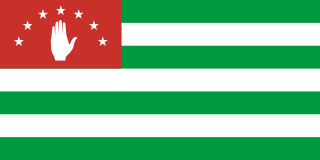
Abkhazia, officially the Republic of Abkhazia, is a partially recognised state in the South Caucasus, on the eastern coast of the Black Sea, at the intersection of Eastern Europe and Western Asia. It covers 8,665 square kilometres (3,346 sq mi) and has a population of around 245,000. Its capital and largest city is Sukhumi.
The War in Abkhazia from 1992 to 1993 was waged chiefly between Georgian government forces on one side, Russian military forces on other side supporting separatist forces demanding independence of Abkhazia from Georgia. http://www.historyorb.com/russia/georgia.php Ethnic Georgians, who lived in Abkhazia fought largely on the side of Georgian government forces. Ethnic Armenians and Russians within Abkhazia's population, largely supported Abkhazians and many fought on their side. The separatists were supported by thousands of the North Caucasus and Cossack militants and by the Russian Federation forces stationed in and near Abkhazia.
The Abkhazia operation was the military operation employed by the Democratic Republic of Georgia. The aim of this operation was to get territory of Abkhazia back which was occupied by Abkhazian Bolsheviks. The operation was successful.

The Rebellion in Tskhinvali was military uprising by Ossetians against the Democratic Republic of Georgia in the city of Tskhinvali in March 1918. The uprising ended with failure.













